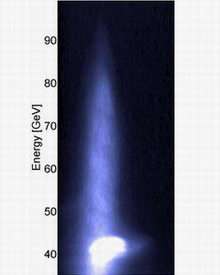New accelerator technique doubles particle energy in just one meter

Imagine a car that accelerates from zero to sixty in 250 feet, and then rockets to 120 miles per hour in just one more inch.
That's essentially what a collaboration of accelerator physicists has accomplished, using electrons for their racecars and plasma for the afterburners. Because electrons already travel at near light's speed in an accelerator, the physicists actually doubled the energy of the electrons, not their speed.
The researchers—from the Department of Energy's Stanford Linear Accelerator Center (SLAC), the UCLA Henry Samueli School of Engineering and Applied Science, and the University of Southern California Viterbi School of Engineering—published their work in the February 15 issue of Nature.
The achievement demonstrates a technology that may drive the future of accelerator design. To reach the high energies required to answer the new set of mysteries confronting particle physics—such as dark energy and the origin of mass—the newest accelerators are immensely bigger, and consequently more expensive, than their predecessors. Very high-energy particle beams will be needed to detect the very heavy and very short-lived particles that have eluded scientists so far.
"We hope that someday these breakthroughs will make future generations of accelerators feasible and affordable," said SLAC Deputy Director Persis Drell. "It's wonderful to see the tremendous progress in understanding the underlying physics for fundamentally new methods of accelerating particles."
While still in early development stages, the research shows that acceleration using plasma, or ionized gas, can dramatically boost the energy of particles in a short distance.
"The scale is pretty remarkable," said SLAC physicist Mark Hogan. "You need an airplane to take a picture of the two-mile linear accelerator here. Yet in a space shorter than the span of your arms, we doubled the electrons' energy to the highest ever made here. I hope in the long term it leads to extending the capabilities of existing and upcoming machines at modest costs."
The electrons first traveled two miles through the linear accelerator at SLAC, gaining 42 billion electron volts (or GeV) of energy. Then they passed through a 33-inch long (84-centimeter) plasma chamber and picked up another 42 GeV of energy. Like an afterburner on a jet engine, the plasma provides extra thrust. The plasma chamber is filled with lithium gas. As the electron bunch passes through the lithium, the front of the bunch creates plasma. This plasma leaves a wake that flows to the back of the bunch and shoves it forward, giving electrons in the back more energy.
The experiment created one of the biggest acceleration gradients ever achieved. The gradient is a measure of how quickly particles amass energy. In this case, the electrons hurtling through the plasma chamber gained 3,000 times more energy per meter than usual in the accelerator.
The recent advance is the culmination of almost a decade work, led by SLAC Professor Robert Siemann, UCLA Electrical Engineering Professor Chan Joshi, and USC Engineering Professor Thomas Katsouleas.
"Physicists use particle accelerators to answer some of the most profound questions about the nature of the universe," said Joshi. "I am hopeful that plasma acceleration will enable us to continue the rich tradition of discovery."
"We are all heartened that we are continuing to climb the plasma acceleration learning curve," said USC Engineering Professor Patric Muggli.
A current experimental limitation is that most of the electrons in a bunch lose their energy to the plasma.
"We take energy out of one part of the beam and put it into another part," Hogan said.
During the last two years, the team has improved the plasma acceleration gradient by a factor of 200. One of the next steps is to attempt a two-bunch system, where the first bunch provides all the energy to the trailing bunch. In a full-scale plasma accelerator, physicists would use those second bunches to create high-energy particle collisions in their detectors.
Source: University of California - Los Angeles





















